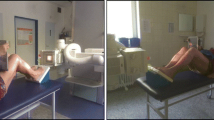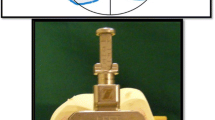Abstract
Purpose
To determine the component fit by radiography or computed tomography after total knee arthroplasty and the relation of imaging with clinical examination of residual knee pain.
Methods
The study was conducted in 172 patients with residual knee pain after total knee arthroplasty. The patients were examined to determine whether they experienced pain upon palpation at nine regions surrounding the tibial and femoral components, and the results were noted. The Knee Society Clinical Rating System and The Western Ontario and McMaster Universities Arthritis Index pain scale score forms were completed for all patients. Radiologic evaluation was performed using computed tomography and anteroposterior, lateral, and oblique radiographs to determine component overhang/underhang status at these nine regions. Overhang, underhang, and cortical fit groups were created based on the position of the component at the bone margin. A statistical relationship was sought between the clinical scores and the values measured to determine which imaging method showed the best correlation with clinical scores. Consistency of CT and Rx measurements was compared using the McNemar–Bowker test. Comparisons between groups were made using Student’s t test for normally distributed data, and the Mann–Whitney U test.
Results
Computed tomography and radiographic measurements were similar in the medial, anterior, and lateral tibial regions. However, no similarities were observed in the anteromedial, anterolateral, posteromedial, and posterolateral tibial regions, and in the distal-medial and distal-lateral aspects of the femur. Statistical relationships among decreased clinical scores, pain with palpation, and the presence of overhang/underhang were only observed in the medial tibial region for imaging using radiography. A statistically significant relationship was observed in the medial, posteromedial, and posterolateral tibial regions, and in the distal-medial region of the femur for imaging based on computed tomography.
Conclusions
Radiography could only aid in assessing the component fit in the anteromedial, medial, and lateral regions of the tibia in patients with residual knee pain following knee arthroplasty, but it was not sufficient in comparison with computed tomography in six other regions.
Level of evidence
Prospective study, level of evidence II.





Similar content being viewed by others
References
Anderson JG, Wixson RL, Tsai D, Stulberg SD, Chang RW (1996) Functional outcome and patient satisfaction in total knee patients over the age of 75. J Arthroplasty 11:831–840
Bessette MC, Amsdell SL, Giordano BD, Kates SL (2017) The utility of postoperative radiographs 2 years after primary total knee arthroplasty. J Arthroplasty 32:106–109
Bilbao A, Quintana JM, Escobar A, Las Hayas C, Orive M (2011) Validation of a proposed WOMAC short form for patients with hip osteoarthritis. Health Qual Life Outcomes 9:75
Bonnin M, Deschamps G, Neyret P, Chambat P (2000) Revision in non-infected total knee arthroplasty: an analysis of 69 consecutive cases. Rev Chir Orthop Reparatrice Appar Mot 86:694–706
Bonnin MP, de Kok A, Verstraete M, Van Hoof T, Van Der Straten C, Saffarini M et al (2017) Popliteus impingement after TKA may occur with well-sized prostheses. Knee Surg Sports Traumatol Arthrosc 25:1720–1730
Chau R, Gulati A, Pandit H, Beard DJ, Price AJ, Dodd CA et al (2009) Tibial component overhang following unicompartmental knee replacement-does it matter? Knee 16:310–313
Diduch DR, Insall JN, Scott WN, Scuderi GR, Font-Rodriguez D (1997) Total knee replacement in young, active patients. Long-term follow-up and functional outcome. J Bone Joint Surg Am 79:575–582
Foruria X, Schmidt-Braekling T, Nabarte DA, Faschingbauer M, Kasparek M, Boettner F (2017) Does the tibia component design affect the need for offset stems in revision total knee arthroplasty? Arch Orthop Trauma Surg 137:853–860
Insall JN, Dorr LD, Scott RD, Scott WN (1989) Rationale of the Knee Society clinical rating system. Clin Orthop Relat Res 2018:13–14
Kumar N, Yadav C, Raj R, Anand S (2014) How to interpret postoperative X-rays after total knee arthroplasty. Orthop Surg 6:179–186
Long WJ, Bryce CD, Hollenbeak CS, Benner RW, Scott WN (2014) Total knee replacement in young, active patients: long-term follow-up and functional outcome: a concise follow-up of a previous report. J Bone Joint Surg Am 96:e159
Mahoney OM, Kinsey T (2010) Overhang of the femoral component in total knee arthroplasty: risk factors and clinical consequences. J Bone Joint Surg Am 92:1115–1121
Matziolis G, Hube R, Perka C, Matziolis D (2012) Increased flexion position of the femoral component reduces the flexion gap in total knee arthroplasty. Knee Surg Sports Traumatol Arthrosc 20:1092–1096
Peersman G, Taeymans K, Jans C, Vuylsteke P, Fennema P, Heyse T (2016) Malrotation deformities of the lower extremity and implications on total knee arthroplasty: a narrative review. Arch Orthop Trauma Surg 136:1491–1498
Seil R, Pape D (2011) Causes of failure and etiology of painful primary total knee arthroplasty. Knee Surg Sports Traumatol Arthrosc 19:1418–1432
Tan TL, Kheir MM, Modi R, Chen CL, Shao H, Chen AF (2017) Midterm Survivorship and complications of total knee arthroplasty in patients with dwarfism. J Arthroplasty 32:3364–3367
Thienpont E, Schwab PE, Cornu O, Bellemans J, Victor J (2017) Bone morphotypes of the varus and valgus knee. Arch Orthop Trauma Surg 137:393–400
Funding
This research did not receive any specific grants.
Author information
Authors and Affiliations
Corresponding author
Ethics declarations
Conflict of interest
The authors have no relevant conflicts of interest to declare.
Ethical approval
The study was approved by the Human Ethics Committee at Yıldırım Beyazıt University.
Informed consent
Written informed consent was obtained from all the patients.
Additional information
Publisher's Note
Springer Nature remains neutral with regard to jurisdictional claims in published maps and institutional affiliations.
Rights and permissions
About this article
Cite this article
Simsek, M.E., Gursoy, S., Akkaya, M. et al. Radiographs are not sufficient for evaluation of component fit in subtle knee pain after total knee arthroplasty. Knee Surg Sports Traumatol Arthrosc 28, 2015–2022 (2020). https://doi.org/10.1007/s00167-020-05940-7
Received:
Accepted:
Published:
Issue Date:
DOI: https://doi.org/10.1007/s00167-020-05940-7




